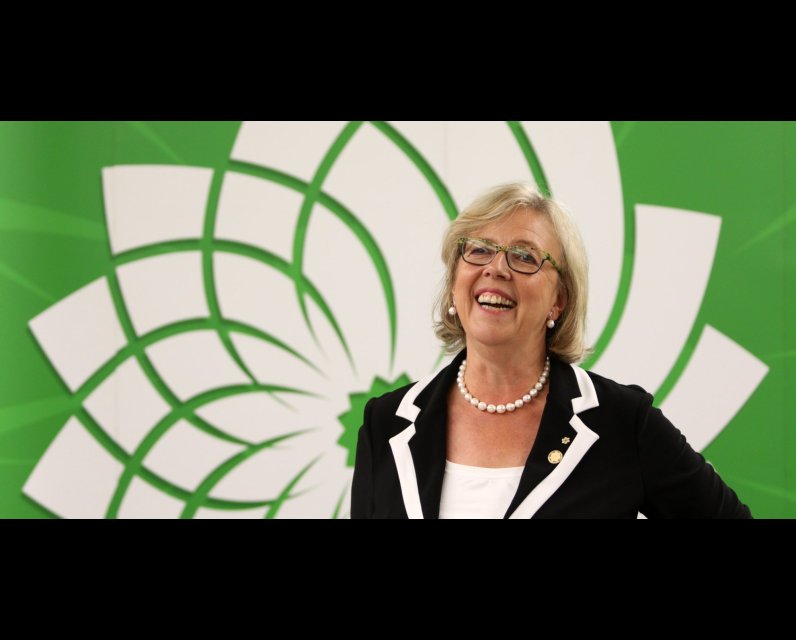Unpublished Opinions
Elizabeth May is an environmentalist, writer, activist, lawyer, and leader of the Green Party of Canada. Elizabeth became active in the environmental movement in the 1970s. She is a graduate of Dalhousie Law School and was admitted to the Bar in both Nova Scotia and Ontario. She held the position of Associate General Council for the Public Interest Advocacy Centre prior to becoming Senior Policy Advisor to the federal minister of the Environment from 1986 until 1988. Elizabeth became Executive Director of the Sierra Club of Canada in 1989, a position she held until March 2006, when she stepped down to run for leadership of the Green Party of Canada.
Elizabeth is the author of seven books, including her most recent Losing Confidence: Power, Politics and the Crisis in Canadian Democracy. She has served on the boards of numerous organizations, including the International Institute for Sustainable Development and as Vice-Chair of the National Round Table on Environment and Economy and is currently a Commissioner of the Earth Charter International Council. Elizabeth became an Officer of the Order of Canada in 2005. In November, 2010, Newsweek magazine named her one of the worlds most influential women. In the 2011 Election, Elizabeth made history by being the first Green Party candidate to be elected to the House of Commons. She is the Member of Parliament for the riding of Saanich-Gulf Islands. In 2012, Elizabeth won Macleans Parliamentarian of the Year award, voted on by her fellow MPs.
Climate: Time to do what is necessary

I write this from the train heading back from New York to Canada. The last time I made this trip was September 2014, coming home from the Peoples’ Climate March. My daughter and I marched with over 400,000 people through the streets of New York, with the explicit goal of encouraging the climate talks to succeed. My favourite placard that day read “It is time to stop debating what is possible and start doing what is necessary.”
That one sentence encapsulates our current debate: some want to keep arguing about what is possible, while the rest of us understand we are running out of time to do what is necessary.
In September 2014 the pressure was for the Lima talks at COP20 to go well enough to create a positive outcome for Paris in 2015 at COP21. But as has been clear from commentary, reasonable people can disagree on how much the Paris Agreement has met the demands in the streets. And complicating this assessment, has been a lot of confused and confusing reporting.
In nearly every media story about the Paris Agreement, new climate targets and how we get there, there are frequent errors. The constant repetition of these errors is not just frustrating; it is dangerous.
If we do not understand the threat of the climate crisis, particularly in terms of its urgency, the forces for status quo policies may win out. Unlike in other crises, the reckless have the advantage of clothing themselves in being “reasonable.” When your house is on fire, it is the reasonable person who says “move fast.” No one would accept a firefighter who says, “Get out the marshmallows. We can linger awhile.”
The difficulty is in sorting out what the Paris Agreement requires of nations, from what Canada has so far committed to do, and what it costs to get there. I have read news articles that assume Canada’s target is consistent with the Paris goals – it is not. I have read stories that assume the new Liberal administration of Prime Minister Trudeau has adopted the previous government’s weak climate target. It has not. I have read articles that claim the Paris Agreement is not legally binding. It is.
These issues tend to get muddled. Even one of my most respected sources of information, the Parliamentary Budget Office, has this week stumbled slightly into error.
Let’s start with the goals of the Paris Agreement. It is a turning point. For the first time 195 nations have essentially agreed that our economies are going off fossil fuels. The treaty calls for reducing emissions sufficiently to avoid global average temperature ever exceeding 2 degrees C above what it was before the Industrial Revolution, while striving to keep the world safer by holding global average temperature to no more than a 1.5 degree rise. That implies keeping concentrations of GHG to no more than 425-450 parts per million. And that measurement means very dramatic reductions in GHG emissions.
The architecture of the Paris Agreement requires countries to place their own plans, both for emission reduction targets, adaptation and financing to help poorer countries, with the United Nations climate secretariat. These targets can be removed at any time, but only to be replaced with more aggressive targets. This is the “ratcheting up” feature of the Paris Agreement.
The current aggregate of all tabled targets of all nations – if achieved – take us to a range of global average temperature increase of 2.7 to 3.5 degrees C. Anyone familiar with climate science will recognize in those temperatures a threat to human civilization itself. They are not merely “failed targets;” they suggest a “failed species.”
No one who negotiated the Paris Agreement can be under the impression that our work is now done. Our work is only beginning.
Of all the currently tabled targets, Canada’s is among the weakest. While the European Nations pledge to reduce GHG to 40% below 1990 levels by 2030, Canada’s pledge is even weaker than the US, and is the weakest of any G7 nation. Our base year is 2005, when emissions were far higher than in 1990. And our deadline year is 5 years later than the US. Under former Prime Minister Stephen Harper Canada pledged to reduce emissions 30% below 2005 levels by 2030.
If Canada wants to have any credibility in signing and ratifying the Paris Agreement, then our target must be significantly boosted. It is time to stop debating what is possible and start doing what is necessary.
But there is push back. Even though Environment and Climate Change Minister Catherine McKenna has always referred to the Harper target as “the floor,” forces are gathering to set that goal in concrete. Bear in mind, Harper never consulted provinces (or anyone) before setting that target. Nor did his government develop any plan. Conservative Climate Critic Ed Fast sets new records for hypocrisy in criticising Trudeau for being prepared to meet Harper’s target. It amounts to a confession that to every climate announcement of the Harper Conservatives there should have been a small asterisk leading to the footnote: “Just kidding!”
There was a Cabinet document prepared for the Conservative administration as the 30% below 2005 by 2030 target was put forward. It suggested that Canada should look to buy credits in other nations.
That thought brings me to where the PBO paper committed two serious errors. Firstly, the PBO is to be commended for undertaking the work. It relied on the NRTEE paper from a few years ago estimating the cost per tonne of reductions within Canada. It also looked at carbon pricing estimates from those calculating how high a carbon price would need to be to meet our targets, by that mechanism alone. The PBO estimate of what it will cost every Canadian is premised on the assumption of a $100/tonne of reduction cost.
But this is an “all hands on deck” kind of moment. Carbon pricing is only one mechanism. Improving energy efficiency, hiring legions of carpenters, electricians and plumbers to reduce the 30% of GHG emissions that come from our leaky buildings, improving the East-West electricity grid to bring green renewable power from one province to another, will accelerate the transition away from fossil fuels. Carbon pricing is a necessary step, but it is not by itself enough and by itself it is too costly.
Moreover, reducing GHG fast enough to avoid 1.5 degrees, we would be smart to put resources into reductions in developing countries where the price per tonne is much lower. The discussion in the Cabinet document to the previous government was right about this. But the PBO paper leaves out this aspect if meeting the 1.5 degrees target. The atmosphere does not care where the GHG come from – a tonne of GHG from India or Venezuela has the same warming impact as a Canadian tonne.
Secondly, the PBO is to be commended as well for figuring out that Canada’s current target does not meet even the 2 degree C level of ambition. So PBO describes the current Harper target as “interim.” The implication is that sometime before 2030 we have time to move to a tougher target. But we do not. Carbon dioxide emitted today remains powerfully warming the atmosphere for another 100 years. As Secretary General Ban Ki-moon explained at the United Nations signing ceremony on Earth Day 2016, the window is rapidly closing on our opportunity to keep global average temperature below 1.5 degrees. We must ramp up targets faster and everywhere.
And here is where Canada can play the most important role. We need to lead in ratcheting up our target. We need to add up all the current provincial plans and demand more of provincial governments while pressing the federal government to use all of its jurisdiction and powers to be much more aggressive. Fortunately, spending on green infrastructure will help our economy. Fortunately, catching up with other countries’ investments in clean tech and green tech will create more jobs.
The risk is not in doing too much to address the climate crisis. The threat is of reckless complacency and the siren call to “be reasonable.”



Comments
Be the first to comment